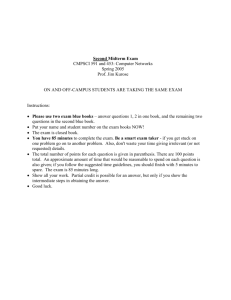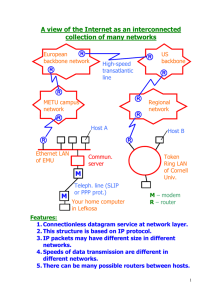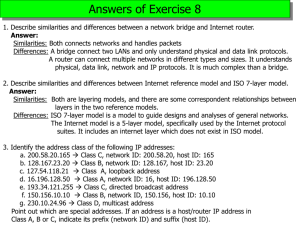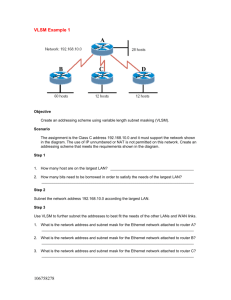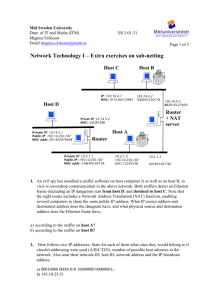Class A
advertisement
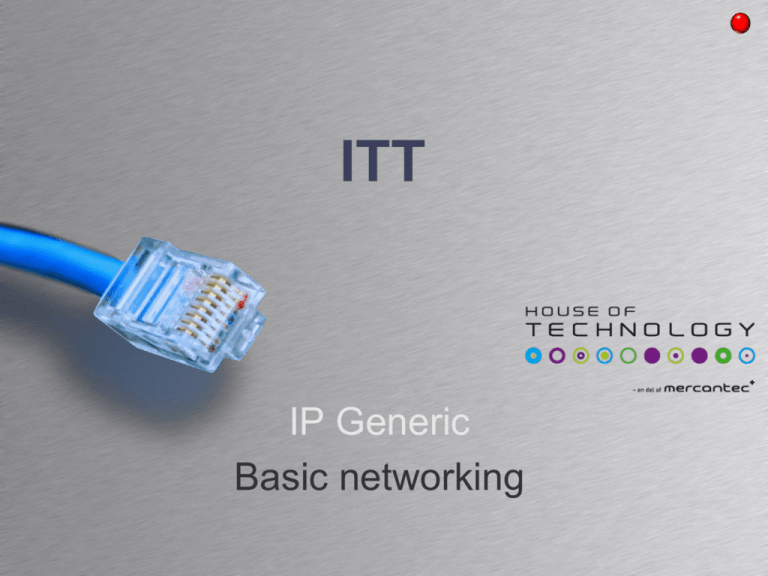
ITT IP Generic Basic networking Basic Networking • • • • • • • • Numeric systems and bits and Bytes. Ethernet (MAC Address etc.). The IP Address/Subnet mask. ARP: Binding the MAC and IP address together. Switching. VLAN. Default Gateway and basic Routing. Exercises during session: – Find your own MAC and IP address. – Commands: ipconfig, ping and traceroute. NUMERIC SYSTEMS BITS AND BYTES Numeric systems Binary • B16 = 1110 • 16 = hexadecimal • 10 = decimal • B16 = 10112 • A616 = 101001102 • B616 = 18210 • B16 = 1110 • 616 = 610 B616 = 1110 x 1610 + 610 = 18210 D 0 0 0 0 0 0 0 0 1 1 1 1 1 1 1 1 C 0 0 0 0 1 1 1 1 0 0 0 0 1 1 1 1 B A 0 0 0 1 1 0 1 1 0 0 0 1 1 0 1 1 0 0 0 1 1 0 1 1 0 0 0 1 1 0 1 1 decimal Hexadecimal 0 1 2 3 4 5 6 7 8 9 10 11 12 13 14 15 0 1 2 3 4 5 6 7 8 9 A B C D E F Calculator • Windows 7 calculator in programmer mode Translating hex to binary Binær 10A7:9CBA76F3 D 0 0 0 0 0 0 0 0 1 1 1 1 1 1 1 1 C 0 0 0 0 1 1 1 1 0 0 0 0 1 1 1 1 B 0 0 1 1 0 0 1 1 0 0 1 1 0 0 1 1 A 0 1 0 1 0 1 0 1 0 1 0 1 0 1 0 1 deci mal Hexadeci mal 0 1 2 3 4 5 6 7 8 9 10 11 12 13 14 15 0 1 2 3 4 5 6 7 8 9 A B C D E F 0001 0000 1010 0111 : 1001 1100 1011 1010 0111 0110 1111 0011 Storage capacity • One Byte is 8 bits – For example 101101112 • • • • • • • • • 1 KiloByte (KB) = 1.024 bytes = 210 bytes 1 MegaByte (MB)= 1.048.576 bytes = 220 bytes 1 GigaByte (GB) = 1.073.741.824 bytes = 230 bytes 1 TeraByte (TB) = 1.099.511.627.776 bytes = 240 bytes 1 PetaByte (PB) = 1.125.899.906.842.624 = 250 bytes 1 exabyte (EB) = 1.152.921.504.606.846.976 bytes ….. 1 zetabyte (ZB) = 1.180.591.620.717.411.303.424 bytes … 1 yottabyte (YB) = 1.208.925.819.614.629.174.706.176 … …. Serial vs. parallel • Serial transmission: (One wire) – One bit is transferred at a time – Examples: • Ethernet • SATA (harddisk interface) • USB • Parallel transmission: (Multiple wires) – Multiple bits are transferred at a time – Examples • 32 or 64 bit CPU Transmission speeds • Measured in bits per second(bps) • Or Bytes per second (Bps) – Note B = Byte and b = bit – 10 Mbps = 10 Mega bits per sekund – 10 mbps = 10 milli bits per sekund (slow) • Ethernet speeds range from – 10 Mbps to 100 Gbps Communications buzzwords • UNICAST: – Communications from One host to One host. – Like a telephone conversation • MULTICAST: – Communications from One host to multiple hosts – Like a radiostation. One transmitter • HALF DUPLEX: – Communications between two hosts Communications buzzwords • • • • Unicast Multicast Broadcast Half and full duplex Unicast • Unicast transmission is the sending of messages to a single network destination identified by a unique address Multicast • Multicast is the sending of a message to a group of destination computers simultaneously in a single transmission from the source A B C D E Broadcast • Broadcast is the sending of a message to a all computers simultaneously in a single transmission from the source A B C D E Half duplex • A half-duplex (HDX) system provides communication in both directions but only one direction at a time – (not simultaneously). Full duplex • A full-duplex (FDX) allows communication in both directions to happen simultaneously. ETHERNET Robert Metcalf’s presentation of Ethernet in June 1976. Ethernet • Purpose of Ethernet: – To exchange digital information between connected stations. – Works within limited geographically areas. • LAN – Local Area Networks • Typically limited to 100 meters in diameter – High speed: 10 Mbps to 100 Gbps Ethernet • Purpose of Ethernet: – To exchange digital information between connected stations. – Stations address each other with unique MAC Addresses (Usually written in hexadecimal) • E.g. 0010E2F11671 or 00-10-E2-F1-16-71 MAC Address • MAC addresses are administered by IEEE • MAC addresses are 48 bits wide – Example of presentations of same address • Windows presentation: 00-10-F4-A3-10-41 • UNIX/Linux presentation: 00:10:F4:A3:10:41 • Cisco presentation: 0010.F4A3.1041 • MAC addresses are unique – Burned into hardware electronics MAC Address You can find the list of OUI if you search for “mac vendor” on google MAC Address - Task • What is your computers MAC address • Who produced it? • Is it global unique or changed? . The IP address (Version 4) IP Version 4 • The IPv4 address consists of 4 bytes (32 bit) • Decimal dotted notation fx. 194.182.53.13 – Dots between each 8 bit byte – Binary 11000010.10110110.00110101.00001101 • Each byte can be in the range from 0 to 255 255 = 111111112 The IP address • An IP address consists of two parts: – A logical network address – A host address • Example: Network address 169.16.32.45 Host address The subnet mask • The subnet mask is used to split the IP address into a logical network and host part. - 255 indicates part of the network address – 0 indicates part of the host address • Logical network address: • Host address: 172.16 0.100 The subnet mask • Logical network address: • Host address: 10 78.67.100 – Or in other words. The host address is 78.67.100 and the host belongs to the logical network address 10 The subnet mask - Task •Find the IP address of your computer using the ipconfig command – What is the network address? – What is the host address? – What is the subnet mask? •What other kinds of information do you get from the ipconfig command? Physical vs. Logical • A physical network is a number of hosts connected to a shared media where they can communicate with each other based on MAC addresses – E.g. • Hosts connected via ethernet hubs/switches. • Hosts connected to a wireless WiFi network • A logical network is the network part of an IP address, as specified by the subnet mask. IP connectivity • All the hosts below can communicate with each other via IP packets because: – All hosts are on the same physical network – All hosts belong to the same logical network IP: 194.182.53.10 Subnet: 255.255.255.0 IP: 194.182.53.12 Subnet: 255.255.255.0 A C IP: 194.182.53.11 Subnet: 255.255.255.0 IP: 194.182.53.13 Subnet: 255.255.255.0 B D IP connectivity • Host B in the drawing below has no IP connectivity with the other hosts below. – All hosts are on the same physical network - but Host B belongs to another logical network. No router present to route packets between logical networks The ping command • Built in test function in IP • Send IP test packet(s) to receiver – Commonly known as a ping packet – In technical terms called a echo request packet • Receiver responds test packets – In daily terms called a pong packet – In technical terms called a echo reply packet • Notice: – Firewalls often block ping packets. The ping command Network drawings • The drawing below has a lot of numbers • Hosts are on same physical network and must be on same logical network in order to communicate IP: 194.182.53.10 Subnet: 255.255.255.0 IP: 194.182.53.12 Subnet: 255.255.255.0 A C IP: 194.182.53.11 Subnet: 255.255.255.0 IP: 194.182.53.13 Subnet: 255.255.255.0 B D Logical network • Gathering the information. • All hosts on the physical network belong to the same logical network. – Easier to understand and change 10 12 A C Logical network address Network: 194.182.53.0 Subnet: 255.255.255.0 Host address 11 13 B D The ”easy” way • The subnet mask is four bytes or 32 bits – For example 255.255.255.0 • In binary 11111111.11111111.11111111.00000000 – The first 24 bits are all ones Net: 194.182.53.0 Subnet: 255.255.255.0 = 194.182.53/24 • This notation technique is called the prefix method Prefix notation • Gathering the information. • All hosts on the physical network belong to the same logical network. – Easier to understand and change Prefix notation - examples 0.10 Logical network including prefix /16 = 255.255.0.0 A 18.11 B Network: 172.16.0.0/16 8.12 C 78.13 Host address 0.1.10 A Logical network including prefix /8 = 255.0.0.0 118.89.11 B 118.88.13 D Network: 10.0.0.0/8 0.1.12 C Host address D IP address classes • Originally the IP address was divided in three unicast areas called Classes. – Class A: Huge networks • 16,7 million IP addresses – Class B: Big networks • 65536 IP addresses – Class C: Small networks • 256 IP addresses IP address classes • The value of the first byte indicates which class the IP address belongs to. – Class A: • The first byte is between 0 and 127 • For example 13.56.89.225 – Class B: • The first byte is between 128 and 191 • For example 182.56.89.225 – Class C: • The first byte is between 192 and 223 • For example 201.56.89.225 Class examples IP address 13.2.3.4 Class C address 194 is between 192 and 223 og 194.182.53.13 Class A address 13 is between 0 and 127 Subnet masks and classes • Each class has its own subnet mask – Class A: • Subnet mask 255.0.0.0 – Class B: • Subnet mask 255.255.0.0 – Class C: • Subnet mask 255.255.255.0 IP Classes Class Purpose First byte between A Unicast 0 and 127 B Unicast C Unicast Subnet mask Prefix Max hosts 255.0.0.0 /8 16.777.214 128 and 191 255.255.0.0 /16 65.534 192 and 223 255.255.255.0 /24 254 Additional classes Class Purpose First byte between D Multicast 224 and 239 E Reserved 240 and 255 Subnet mask None special None Prefix Max hosts None - None - Unicast classes • With the growth of the Internet, it was realized that dividing the IP unicast address space in three classes was inefficient. • Today IP addresses are classless. • All IP addresses can use all subnet masks • The class concept however is still used Documentation - Task • Draw a diagram over the network you are located on. Including: – The computers in your own group & the group next to you. – Network part/Subnetmask – Host part – Last 4 numbers in the mac address 0.1.10 A Logical network including prefix /8 = 255.0.0.0 118.89.11 B 118.88.13 D Network: 10.0.0.0/8 0.1.12 C Host address BASIC ROUTING Between logical net 10 11 12 13 Router 1 Net: 194.182.53/24 WAN link Net: 182.114/16 1.1 Router 61.13 61.14 67.19 112.4 Between logical net 10 11 12 13 Router 1 Net: 194.182.53/24 WAN link Net: 182.114/16 1.1 Router 61.13 61.14 67.19 112.4 Default gateway 10 11 12 13 Router 1 Net: 194.182.53/24 WAN link Net: 182.114/16 1.1 Router 61.13 61.14 67.19 112.4 The route table • The route table is a list of all known logical networks the hosts know. • If the hosts don’t know a specific logical network, they will use the default gateway – if present. – Logical gateway is known as 0.0.0.0/0 • 0.0.0.0/0 means all networks with all subnet masks The route table 10 11 12 13 Router 1 Net: 194.182.53/24 WAN link Net: 182.114/16 1.1 Router 61.13 61.14 67.19 112.4 Understanding the route table • Each line represents a known logical network List of known logical networks The subnet mask of each known logical subnet mask Command to see the route table Which interface to send the packets out of The gateway (router) to send the packet to. If not on-link (Same physical network) Understanding the route table • If the host have to send a packet to the destination 194.182.53.67 it will search the route table and find two possible ways to the destination – 0.0.0.0/0 via 194.182.53.1 out of interface 194.182.53.13 – 194.182.53.0/24 on-link out of interface 194.182.53.13 • It will choice the most specific route. The one with the best subnet mask. /24 is better than /0 Understanding the route table • If the host have to send a packet to the destination 8.8.8.8 it will search the route table and find one possible way to the destination – 0.0.0.0/0 via 194.182.53.1 out of interface 194.182.53.13 • The packets to 8.8.8.8 will be send to the default gateway as 8.8.8.8 is on another logical network Showing the route table • Find the route table on your computer using the route print command • What is the exit-point in the network • Add this Default gateway to the network diagram IP Summary • A host can send direct to other host on its own logical network • To send to hosts on other logical network the host need to know a router. – A router is an intermediate device which passes packets on towards its destination. • 172.16.0.0/16 is a class B net – Network: 172.16.0.0 – Subnet mask: 255.255.0.0


